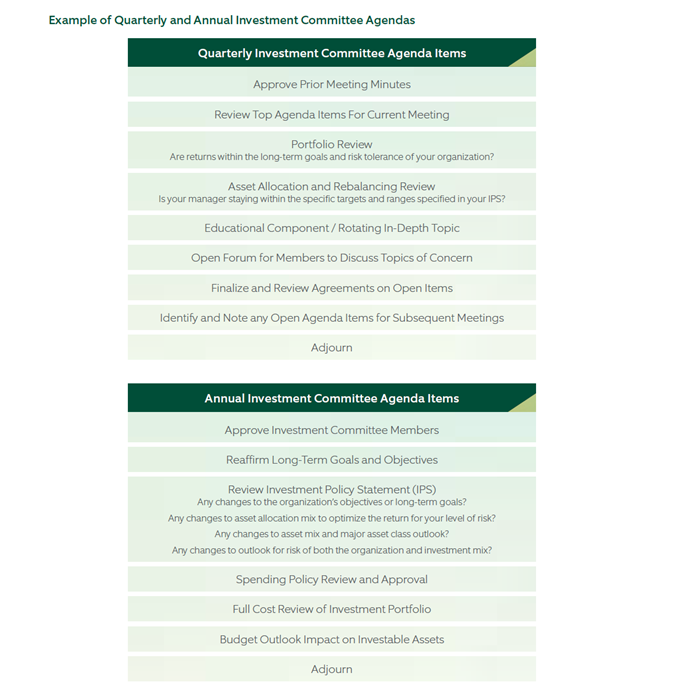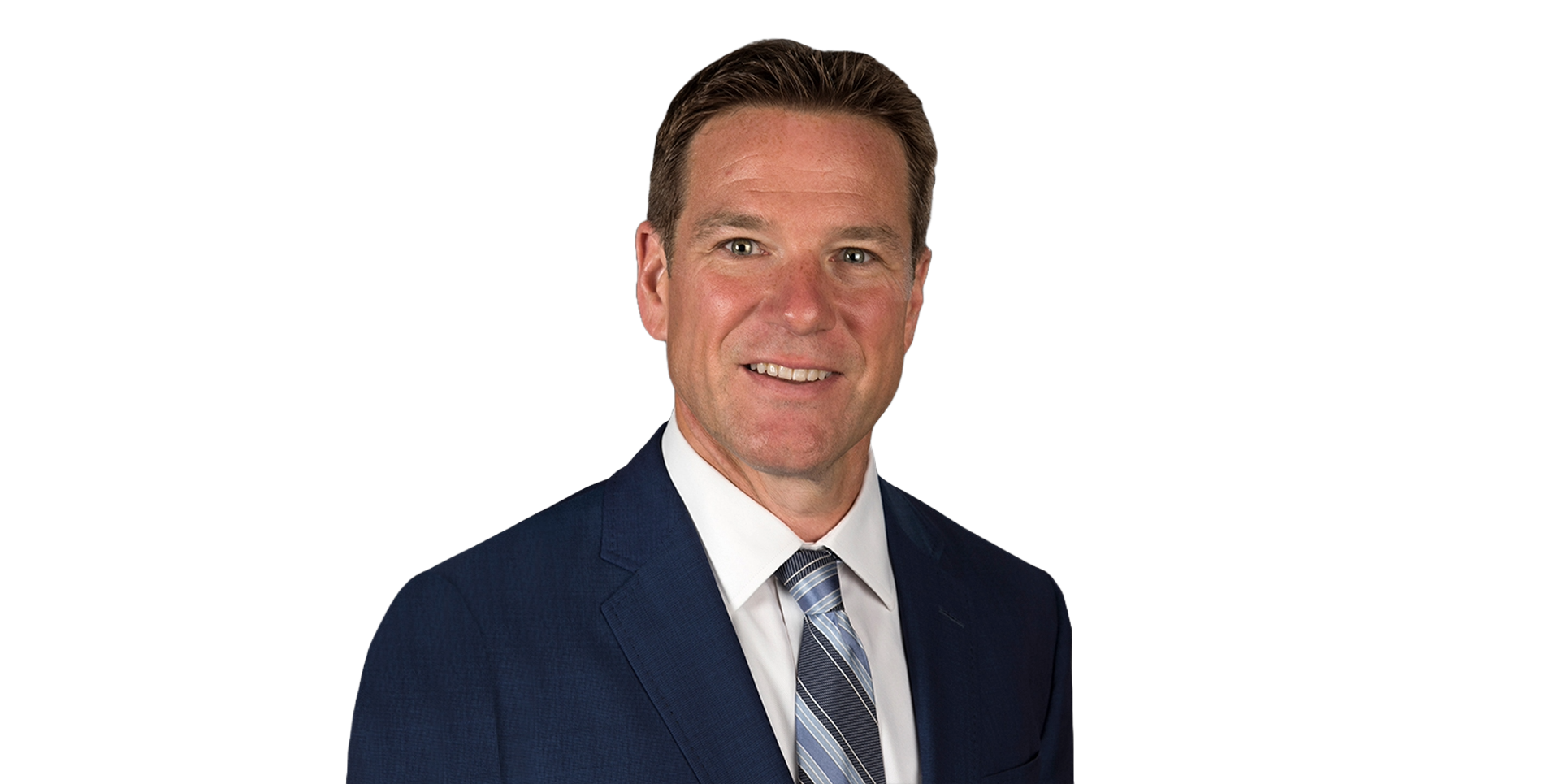- Who We Serve
- What We Do
- About Us
- Insights & Research
- Who We Serve
- What We Do
- About Us
- Insights & Research
Investment Committee Best Practices: Running an Effective Meeting
Learn how to run an effective meeting so that proper decision-making is completed efficiently, which is fundamental to the success of the committee.
By John Ferguson, CFA Chief Investment Officer, Foundation & Institutional Advisors
Patrick Nolan, CFA, CMT Senior Portfolio Manager, Foundation & Institutional Advisors
Successful meetings are the key determinant of a strong Investment Committee. Much of the action for an Investment Committee takes place during these meetings. Therefore, running them to ensure proper decision-making is completed efficiently is fundamental to the success of the committee.
The responsibility for meetings typically falls on the committee chair, who is usually supported by staff. It is best to schedule meetings at a regular cadence so staff, committee members and presenters can plan accordingly. Often, the meetings are scheduled right before the full board meeting where the chair can give a brief update and call for resolutions when needed.
Much of the work is done prior to the meeting, which should be steered with a well-defined agenda. The agenda is typically set by the committee chair and should include a clear objective for each item. In building the agenda, the chair should review unresolved issues from the prior meeting and past records to make sure all important items are included. It is best practice to put the most important agenda items early in the meeting to ensure appropriate time is spent on those items with the highest impact. These tend to be discussions around spending, strategic asset allocation, and operational needs.
It is essential for the committee chair to keep everyone focused on the agenda. Without an effective committee chair, members’ emotions usually take hold, and personal viewpoints, along with their biases, take over. Once this starts, rational discourse takes a back seat, leading to arguments that could derail the conversation and ultimately undermine the productivity of the meeting and its discussions. Most boards are made of volunteers, and it is difficult to add special meetings to resolve issues. Without proper structure, debates can continue for years and the default is typically maintaining status quo.
The chair should specify an amount of time for each item so that all have the proper allocation for resolution and the meeting comes to a timely close. We find that the most effective chairs allocate proper time for debate, close the debate, and call for a vote. Timing a person’s comments ensures members are prepared when they have the floor and also limits the time of board members who tend to have the loudest voice. One effective chair made a point of recognizing each trustee for a comment. In one debate on allocating to private debt or private equity, there was momentum against private debt until one quiet member was recognized. As a former banker, this member had some unique insight that led to a board vote in favor. Another effective practice by a chair is to give the final word to one of the members before going to a vote. We have seen board members lobby to have this last word, hoping to influence the group to a certain opinion so it is important for the chair to select someone carefully. Occasionally, the chair will recognize the Outsourced Chief Investment Officer (OCIO) if discussions get off-point. The OCIO should be prepared with a firm opinion on important issues.
For efficiency, we recommend a pre-meeting with the chair, staff and OCIO team to make sure all parties are aligned with the goals of the discussions, as well as preparing supporting materials for dissemination. A draft of the agenda and presentation materials are typically reviewed at this meeting. Staff can also discuss organizational needs and cash movement at a micro-level. The chair then makes the final decision on the content and steers the OCIO on any issues voiced by the board that need to be addressed.

Once you join an Investment Committee, it is your job as a new member to review past meeting minutes, along with the Investment Policy Statement, and to ask questions to the committee chair to share institutional knowledge that may not be outlined in the documents.
Committee members are responsible for:
- Attending every meeting
- Preparing prior to meetings by reviewing all materials supplied and understanding the decisions that will be asked of them during the meeting
- Looking to be an active participant in the meeting and being open to new ideas
- Putting the organization’s interests ahead of personal biases and doing what they feel is best for the organization’s long-term success
The worst thing a committee member can do during a meeting is to sit in silence. Not contributing to the discussion and voting along with stronger personalities to minimize conflict generates groupthink, conforming to the consensus without critical reasoning or evaluation of the consequences or alternatives. The chair can engage the group to encourage critical thinking, but it also helps to have a diverse committee with different backgrounds who can offer unique insights and perspectives from their lives, knowledge, experience and particular area of expertise.
To be an effective Investment Committee, you need to make decisions. It is fine that the committee may not come to a unanimous decision. When there is a difference of opinion on a topic, committees tend to push important decisions off to future dates. Inevitably, these items never get decided upon, creating the same discussion, frustration and arguments in future meetings. We recommend all items go to a vote, even if there are dissenters, to get the important decisions made.
Detailed meeting minutes should be compiled by a nonparticipant. Since the nonparticipant may not have the expertise to capture the important points, often the OCIO will provide notes and review the minutes to ensure relevant data is captured. It is a best practice to release a draft of the minutes for review so that members can provide feedback or request for more details to be added. Minutes usually cover the agenda items, important discussion points, questions and objections, and final decisions. Typical meetings are not recorded, so for governance, it is a best practice for the committee to approve the meeting minutes.
Effective committee governance and decision-making are pivotal within a successful Investment Committee. Boards that, through their Investment Committee, adopt a focus on governance first and foremost generally see better portfolio performance.
LEARN MORE
To help meet your investment and advisory needs, Foundation & Institutional Advisors (FIA) is Northern Trust’s national practice that exclusively serves foundations, endowments and other nonprofit institutional investors as either a dedicated investment advisor or as a fully outsourced chief investment officer. The practice is consultative and advice-driven, providing holistic solutions that combine sophisticated advisory expertise with a spectrum of value-added services.
Meet Your Expert
John Ferguson
CFA, Chief Investment Officer, Foundation & Institutional Advisors

Patrick Nolan
Patrick Nolan
CFA, CMT, Senior Portfolio Manager, Foundation & Institutional Advisors

© 2024 Northern Trust Corporation. Head Office: 50 South La Salle Street, Chicago, Illinois 60603 U.S.A. Incorporated with limited liability in the U.S.
This document is a general communication being provided for informational and educational purposes only. The opinions and conclusions expressed herein are those of the authors and are not meant to be taken as investment advice or a recommendation for any specific investment product or strategy and does not take your financial situation, investment objective or risk tolerance into consideration. Performance examples are hypothetical and for illustration purposes only and actual results may be lower or higher than a portfolio that may be more or less diversified and/or managed in a different manner. In performing its services, Northern Trust will take into account other relevant facts and circumstances such that positions and transactions for any particular client account may differ with the investments described herein. Northern Trust provides fiduciary and investment management services to various types of accounts, including but not limited to, separately managed accounts, registered and unregistered funds. The investment advice given to one client account may differ from the investment advice given to another client account. Northern Trust and its affiliates may have positions in, and may effect transactions in, the markets, contracts and related investments described herein, which positions and transactions may be in addition to, or different from, those taken in connection with the investments described herein. All information discussed herein is current only as of the date of publication and is subject to change at any time without notice. This material has been obtained from sources believed to be reliable, but its accuracy, completeness and interpretation cannot be guaranteed. Readers, including professionals, should under no circumstances rely upon this information as a substitute for their own research or for obtaining specific legal, accounting or tax advice from their own counsel.
All investments involve risk and can lose value. The market value and income from investments may fluctuate in amounts greater than the market. Forecasts may not be realized due to a multitude of factors, including but not limited to, changes in economic conditions, corporate profitability, geopolitical conditions or inflation.
LEGAL, INVESTMENT AND TAX NOTICE. This information is not intended to be and should not be treated as legal, investment, accounting or tax advice.
PAST PERFORMANCE IS NO GUARANTEE OF FUTURE RESULTS. Periods greater than one year are annualized except where indicated. Returns of the indexes also do not typically reflect the deduction of investment management fees, trading costs or other expenses. It is not possible to invest directly in an index. Indexes are the property of their respective owners, all rights reserved.